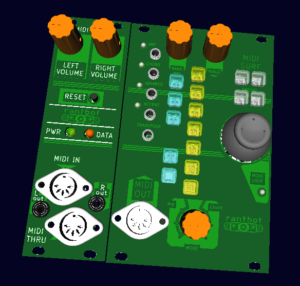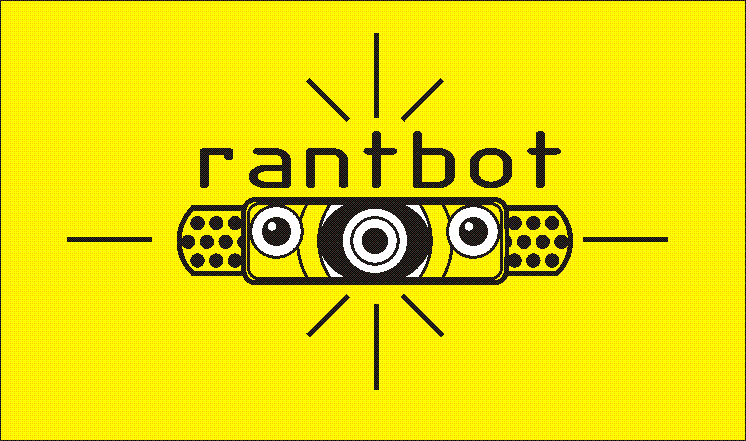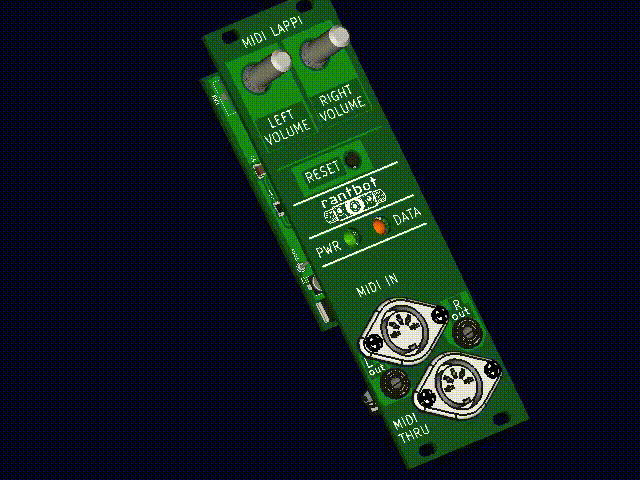Rantbot welcomes you. Rantbot is a one-man operation that designs and builds a limited number of custom eurorack music modules. Currently available via https://reverb.com/item/62820533-rantbot-midi-lappi-eurorack-midi-sound-module
MIDI-Lappi eurorack module
MIDI-Lappi is a module designed and built by Rantbot. It is based on VS1053 chip from the VLSI company in Finland. It accepts MIDI input (but NOT SysEx messages) and produces stereo audio outputs from General MIDI sound set. MIDI-Lappi brings retro General MIDI sounds to the eurorack palette. Power and Data LEDs do what you would expect, and provide some comfort. A small RESET switch clears everything and starts over with a nice General MIDI Piano voice for incoming Note On commands.
Standard MIDI DIN connectors provide MIDI IN and MIDI THRU ports. The MIDI THRU connector is provided purely for your convenience. It is not required for MIDI-Lappi operation.
MIDI is a technical standard that describes a communications protocol, digital interface, and electrical connectors that connect a wide variety of electronic musical instruments, computers, and related audio devices for playing, editing and recording music, per Wikipedia.
The MIDI-Lappi module assembly includes an Adafruit https://www.adafruit.com/product/1381 VS1053 codec board, configured as a General MIDI sound source.
MIDI-Lappi adds opto-isolated MIDI IN, and buffered MIDI THRU on standard old school DIN jacks.
MIDI-Lappi also adds stereo amplification to make nice loud audio outputs that are more friendly to eurorack voltage levels and impedance. There are separate volume knobs for right and left stereo outputs.
A green Power LED and amber DATA LED provide vital signs.
Finally, a front panel RESET switch is included in case MIDI-Lappi gets lost in space and becomes silent. Or maybe a long note wants to ring forever. Although rare, many MIDI aficionados have had that experience. The RESET switch makes a nice quick clean restart.
One thing that can stun the module are SYS EX messages, they are not supported, according to the VLSI VS1053 data sheet. Also, blasting the module with a heavy data stream of black MIDI will probably require the RESET button at some point.
The lovely tones available are reminiscent of 80’s keyboards. Having precise 12-tone control, polyphony, pitch bend, and layers of sound in a small module can be useful to eurorack synthesists who seek some of the gifts that MIDI has long provided.
Lappi is Finnish cheese that is named so because it was developed in the Lapland province of Finland. It is produced from partially skimmed cow’s milk, making it nearly identical to Swiss cheese, except that the milk is pasteurised. In addition, the cheese is mild in flavour and firm-textured with small holes. The smooth, rich, creamy cheese is sweet to taste and preferred by those who like mild tasting cheeses and are allergic to gluten.
Lappi works well in fondues, adds flavour to smoked turkey and goes well with a dessert wine such as a Riesling, according to cheese.com.
Rantbot knew for years that VS1053 would sound cheesy, and MIDI-Lappi does not disappoint! But what a good cheese.

Ctrl-Surf eurorack module
I connected every MIDI device I could find to MIDI-Lappi and played them. This included Arturia Beatstep Pro, Keystep, MicroFreak, and Casio XW-P1 keyboard in addition to PC thru Roland MIDI converter. On the PC, a favorite was the MIDI-OX program, which to Rantbot is the pinnacle of beauty.
It quickly became desirable to design a new module to extract the best sound flavors from MIDI-Lappi, and fit within a purely eurorack environment. The control surface module would use the reliable PIC18F26K22 chip as the main brain, since I had some of them.
An array of 12 backlit switches is arranged like a vertical one-octave piano, providing notes
C, C#, D, D#, E, F, F#, G, A flat, A, B flat, and B
Presets: A square array of four white backlit pushbuttons are used for selecting and editing presets. Settings are remembered between power cycles. Each preset can include information about the arpeggio notes, chord notes, and the sound of each one.
Two knobs at the top of the Ctrl-Surf module generate the MIDI Program Change messages to select instrument sounds. Rantbot has sifted and sorted thru the VS1053 sound set and arranged them into eight banks of sixteen sounds each. One knob selects a bank of sounds, and the other knob selects an individual sound within that bank.
Ctrl-Surf is divided into two halves, one half for arpeggios, and the other half for chords. The mode knob at the bottom controls whether arp or chord is using the keyboard. Ctrl-Surf runs arp and chord players simultaneously. The keyboard can display and control either arpeggios or chords at any moment, with the choice determined by the Mode knob. When the Mode knob is around the middle of its rotation, the Mode LED is lit, and the degree of rotation controls the volume of the arpeggios, with minimum at CW, approaching the chord solo position. Maximum is in the CCW direction, nearing the arp solo position. The mode LED is dark in either solo mode.
Finally, Ctrl-Surf includes a joystick for the instant gratification of Pitch Bend.
And, if you click the joystick switch, you cycle thru three variations.
Variation 1: Arpeggios on MIDI channel 1 and chords on MIDI channel 2.
Variation 2: Arpeggios on MIDI channel 1 and chords on MIDI channel 2, and percussion (described later) on MIDI channel 10.
Variation 3: Percussion on MIDI channel 10.
Eurorack synthesizers are all about control voltages, clocks and gates, not about MIDI. There are some modules being produced to bridge these gaps. For example, MIDI-to-CV and MIDI-to-Gate. But I have not seen any modules that produce Gate-to-MIDI or CV-to-MIDI.
Ctrl-Surf fills this vacuum by providing four clock/gate inputs and one control voltage input. The four clock/gate inputs each include an LED for visual feedback. Eurorack setups commonly provide a rich source of clock, gate, and CV signals.
The five inputs are:
Arp Clock – Each clock pulse advances the arpeggio by one note.
Chord Strike – Each rising gate strikes a chord, the falling gated releases the chord.
Preset Advance – Each clock pulse advances Ctrl-Surf to it’s next stored preset.
Accent – When this gate input is high, notes are played more loudly.
Delta V – This control voltage input is still under development.
The MIDI-Lappi includes the General MIDI percussion sound set on channel 10, so a beat box is already built in. I wrote some Rantbot code to associate the existing inputs to drum strikes inputs. It surprised me how interesting and natural this ended up sounding. I included a small “drummer” algorithm to create an alternating instrument on an input for example hi snare, low snare, or hi timbale, lo timbale. The algorithm looks at the other inputs to make its complex alternating pattern.

